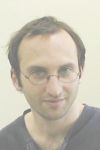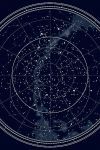
Directory All A-Z
A

Biographical Info
One-pager from the 2023 Jamboree




Biographical Info
I am interested in the study of the birth and evolution of binary stars and planetary systems, dynamics of astrophysical disks, physics of circumstellar dust, with occasional diversions to binary blackholes and AGNs
B





Biographical Info
My research is focused on understanding the structure and formation of galaxies, in particular the Milky Way. I use data from large surveys to investigate the distribution of stars in the Milky Way and how this distribution depends on the age and chemical composition of stars, which allows me to identify the basic processes that govern the formation and evolution of the Milky Way and disk galaxies like it. I am also interested in using the observed kinematics of stars to infer the distribution of mass—dark matter in particular—in our Galaxy. I am an active member of the APOGEE survey, which uses high-resolution, high signal-to-noise infrared spectroscopy to investigate the structure of the bulge and disk regions of the Milky Way, as well as many other topics in stellar and galactic astrophysics.
One-pager from the 2023 Jamboree



C
Biographical Info




D








E

Biographical Info
My research is in the interdisciplinary field of astrostatistics, and I am jointly-appointed between the Department of Astronomy & Astrophysics and the Department of Statistical Sciences. I am interested in using and developing modern statistical methods for astronomy applications to answer fundamental questions about the universe. For example, I use hierarchical Bayesian analysis to study the dark matter halo of the Milky Way and other galaxies, and am developing new time series analysis methods to learn about the internal structure of stars.

F




Biographical Info
Seiji’s research focus on the formation and evolution of galaxies and black holes in the early universe. To link visible and dust-obscured sides of these fascinating systems, he developed an expertise in observational techniques combing the electromagnetic spectrum from optical to radio wavelengths. Seiji has been applying these techniques to his multiple Principal Investigator programs of JWST and ALMA, characterizing three fundamental aspects of the early galaxies such as their chemical enrichment, the assembly history of their stellar dust, gas, dark matter, and kinematics. Seiji has been playing key roles also in large JWST and ALMA programs in collaborations to search for the first emergence of stellar light, dust, blackholes, and stellar explosions in the universe and to investigate the primary formation and evolution mechanisms from the first galaxies in the first billion years after the Big Bang.
G

Biographical Info
My main goal is to understand why the Universe is magnetic. By measuring the polarised radio signals from millions of distant galaxies over the entire sky, I aim to transform our understanding of magnetism in galaxies, clusters and in diffuse intergalactic gas. I also study the ways in which celestial objects change, flicker, flare and explode. I am working to provide a new understanding of the many different populations of transient and variable phenomena, and to develop the novel source-finding and classification algorithms needed to find rare and unusual behaviour in very large data sets. In the next decade, all of this work will culminate in the Square Kilometre Array, a next-generation radio telescope that will answer fundamental questions about the Universe.



H



Biographical Info
My research interests begin with finding and characterizing nearby extrasolar planets using the radial velocity and direct imaging methods. I characterize the planets’ masses and orbits and use large ensembles of planets to study planet demographics and occurrence rates. I am especially interested in the effects of binary star companions on the formation and evolution of exoplanets. Nearly half of all stars like the Sun are binaries, and the gravitational influence of a stellar companion can inhibit the formation or destabilize the orbits of planets orbiting each star. I seek to understand these effects by statistically comparing the occurrence rates and demographics of planets in single vs. binary systems.

Biographical Info
My research focuses on theoretical cosmology and statistical methods in cosmology. I am a member of the Atacama Cosmology Telescope collaboration and the Simons Observatory, which are studying the cosmic microwave background (or CMB) at very sharp angular resolution to unlock the secrets of the early universe and the period of star formation. I use this data to answer questions about the structure of the universe, its initial conditions and its eventual fate using data.
I am also a member of the Dark Energy Science Collaboration of LSST, which is a telescope under construction in Northern Chile, and will scan the sky to deliver a vast amount of cosmic transients. I work on the supernova science with LSST to use the photometric data (without a spectrum of the object) to answer questions about dark energy.
I’m passionate about science communication and outreach, and the intersection of art and science – so contact me if you’re interested in collaboration!
One-pager from the 2023 Jamboree
I

J

K


L

Biographical Info
I am primarily interested in using a combination of simulations, statistics and observations to answer questions about our Universe. Recently, I have used strong gravitational lensing and Bayesian inference techniques to constrain ultra-light dark matter theories. I have also worked on 21cm cosmology, from a theoretical and experimental perspective. For instance, I have investigated the effect of spin temperature on the relationship between matter and ionized hydrogen during the Epoch of Reionization with MCMC methods.
One-pager from the 2023 Jamboree



Biographical Info


Biographical Info
Ting’s research focuses on near-field cosmology. In particular, she studies the stars in the Milky Way Galaxy and nearby galaxies to understand how they form and to understand the nature of dark matter. She specializes in analyzing large data sets from modern surveys and also performs traditional astronomical observations with optical and near-infrared telescopes. Ting also builds astronomical instruments and contributes to infrastructure work for large-area sky surveys such as the Dark Energy Survey (DES), Dark Energy Spectroscopic Instrument (DESI), and others. She is the founder and leader of the Southern Stellar Stream Spectroscopic Survey (S5), a survey to map streams of stars in the sky visible from the Southern Hemisphere to determine the mass profile of the Milky Way. She is also one of the convenors of the DES Milky Way Working Group, as well as one of the Dark Matter Working Group co-chairs of the Maunakea Spectroscopic Explorer, a 11.25-meter telescope facility dedicated to the next generation spectroscopic surveys.
One-pager from the 2023 Jamboree


Biographical Info
I hail from the sunny region of Southern California, where the abundance of dark sky preserves sparked my fascination with the cosmos. My current research is centered on the first observations of massive stars that have had their hydrogen envelopes removed by their binary companions. These stripped stars hold great significance in nearly every realm of astrophysics, spanning from potential sources of gravitational waves to their role in cosmic reionization.
One-pager from the 2023 Jamboree
M



Biographical Info
One-pager from the 2023 JamboreeMatzner


Biographical Info

Biographical Info
My research focuses on reconstructing the formation conditions of the Milky Way using the positions, kinematics, ages, and chemical compositions of pulsating variable stars. I use data from proprietary surveys and publicly available databases, including (but not limited to) the Halo Outskirts With VAriable STars (HOWVAST), the Southern Stellar Stream Spectroscopic Survey (S⁵), and the Gaia mission. These projects are pivotal to lay the groundwork for exploiting the large amount of data upcoming in the next generation of large sky surveys.

Biographical Info
I am an observational cosmologist that develops novel instrumentation and analysis techniques for studying the origin, composition, and evolution of the universe. One of such instruments is the Canadian Hydrogen Intensity Mapping Experiment (CHIME), a ground-breaking radio telescope that is mapping the large-scale structure of neutral hydrogen to constrain the expansion history of the universe. Thanks to its unique design and powerful digital backend, CHIME has also become a leading facility for studying the radio transient sky, including the mysterious fast radio bursts (FRBs). I am now focused on the development of CHIME/FRB Outriggers and the Canadian Hydrogen Observatory and Radio-transient Detector (CHORD), next-generation telescope arrays that will provide unprecedented observational capabilities for cosmology and radio transient science.
One-pager from the 2023 Jamboree

Biographical Info
My primary research interest in theoretical astrophysics is the study of the structure and evolution of planets, accretion discs and stars. The fluid dynamics of these objects is a topic I particularly enjoy exploring, through a combination of analytical and numerical simulation work.


Biographical Info
One-pager from the 2023 Jamboree


Biographical Info

N

Biographical Info
I use simulations to study gravitational waves signals from inflation and forecasting for the CMB satellite LiteBIRD. I believe it is very important to increase the visibility of minoritized groups, increase diversity, and help make academia a more welcoming and accepting place. Alongside my research, I am also very engaged with public outreach in order to promote enthusiasm for science in youth and advocate for diversity.

Biographical Info
I study both the cosmic microwave background and the galactic star formation using a number of
balloon born instruments (BLASTpol, Spider, BIT).

P



Biographical Info
One-pager from the 2023 Jamboree



Biographical Info
I was born and raised on Cape Breton Island in the province of Nova Scotia. My research is typically theoretical and computational, though I like including observational data whenever possible to stay grounded in reality. I’m interested in non-ideal magnetohydrodynamics and its applications to all aspects of star formation in astrophysics.
Q

R



S







Biographical Info
As a member in the SDSS-V collaboration, I work mainly on developing and running the spectral analysis pipelines for the Milky Way Mapper (MWM). My research focuses on analysing the chemo-dynamical properties of star clusters and stellar populations in the Milky Way and nearby dwarf galaxies. I also developed a real-time extraction GUI software for a new IFU instrument (IFU-M) designed for use on the Magellan/Clay telescope.

Biographical Info
I am a Banting-Dunlap Postdoctoral Fellow jointly hosted between the
Department of Statistical Sciences, the Department of Astronomy &
Astrophysics, and the Dunlap Institute. My research focuses on using a
combination of astronomy, statistics, and computer science to combine and
analyze billions of stars and galaxies from wide-field imaging and
spectroscopic surveys to better understand the how galaxies like the Milky
Way form, behave, and evolve over time.

Biographical Info
T




V

Biographical Info
The characterisation of the low-mass planets: super-Earths and mini-Neptunes. The former are planets that are mostly solid, either rocky or icy in composition, while the latter posses also a volatile
envelope. My goal is to determine if planets with masses between 1-15 Earth-masses are scaled up versions of Earth, or scaled-down versions of Neptune in terms of their composition, evolution and physical properties.

Biographical Info
I am interested in compact objects, stars and binaries, their structure, formation and evolution, and their use to infer fundamental physical properties. My research is based on observations, but includes interpretation, theory and numerical modelling as required. Currently, I am trying to use neutron stars to study physics in conditions out of reach of terrestrial experiment, and to solve associated astronomical puzzles. I’ve become particularly intrigued by the possibilities of extremely high resolution astrometry offered by pulsar scintillation.

Biographical Info
Currently a first year PhD student, I obtained my BSc in Earth Science (Geophysics specialization) from University of Waterloo in 2015. Afterwards, I briefly worked in engineering consulting before spending several years working in tech, and am now happily dedicated to my passion for astrophysics.

Biographical Info
My primary research interests involve the Large Scale Structure (LSS) in the Universe. By studying its properties and evolution, we can make firm statements about the physical processes which must have been active. Despite — or perhaps because of — its size, the LSS is difficult to observe, and specialized instruments and surveys are required to study it. I work on two such instruments, the South Pole Telescope (SPT), and the Canadian Hydrogen Intensity Mapping Experiment (CHIME)

W



Biographical Info
One-pager from the 2023 Jamboree
X

Y




























